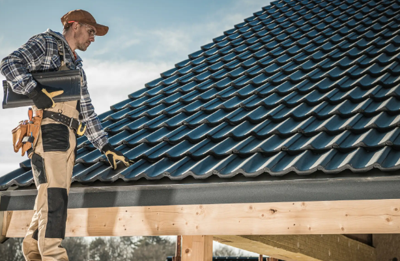
When you think about the parts of your home that protect you, what comes to mind? Maybe your front door. Your locks. The walls around you. But here's the thing—your roof does more heavy lifting than almost anything else, and most of us don’t give it a second thought until something goes seriously wrong.
The truth? Your roof could be hiding some serious problems. Problems that quietly build up over time, and when they finally show themselves, they hit hard. Let’s talk about why your roof might be the biggest blind spot in your home safety plan.
We Trust Our Roofs More Than We Should
Most of us assume the roof is fine because, well, it looks fine. No leaks, no obvious damage. And hey, if it ain't broke, right?
Wrong. Roof problems often start small. A cracked shingle here. A bit of moisture there. Nothing that screams emergency. But the damage adds up. And since we don't look up very often, those warning signs fly under the radar.
Think of it like a cavity in your tooth. By the time you feel pain, the damage is deep.
Small Issues, Big Trouble
Here's the scary part: it doesn’t take much for a tiny roof issue to become a full-blown disaster. One loose shingle can let in just enough water to cause mold. A small leak in the attic can soak insulation and rot the wood underneath. Before you know it, you've got ceiling stains, warped drywall, maybe even electrical issues.
Moisture is sneaky. It spreads fast. And once it’s inside, it invites all kinds of uninvited guests—mold, mildew, even pests like termites and rodents. They love damp, dark places. Your attic? Perfect real estate.
And guess what? Insurance doesn’t always cover damage that happens because of "neglect."
Weather Wears It Down Fast
Let’s be real—your roof takes a beating. Sun, rain, snow, wind, hail. Day in and day out, it's your home’s first line of defense. But that constant exposure wears it down.
We’re seeing more extreme weather every year. Storms are stronger. Seasons are shifting. And roofs that were installed even 10 or 15 years ago might not be holding up like they used to.
After a big storm, the damage might not be obvious from the ground. But up close? There could be cracked shingles, torn flashing, or worse. And unless someone climbs up there to check, you’d never know.
What’s Actually Up There?
Most homeowners have a general idea of what a roof looks like from the outside, but not many could tell you what goes into its structure. And yet, knowing the parts of a roof can make a huge difference. When you understand how all the layers work together—from the decking to the flashing—you start to notice things you might otherwise miss. This basic knowledge gives you a better shot at spotting early warning signs before they turn into costly problems.
The Safety Risks You Can’t See
You might think the worst thing that can happen is a leaky ceiling. But the risks go beyond drips and water stains.
A failing roof can literally fall apart. That might sound dramatic, but it's happened. Water damage weakens the structure. If a heavy storm hits, sections can collapse. Debris can fall. And that’s not just a property issue—it’s a serious safety hazard.
Plus, mold from a damp attic can circulate through your HVAC system. You won’t see it, but you might be breathing it in. For kids, elderly folks, or anyone with allergies, that can be a big problem.
It's Costing You More Than You Think
Even if you’re lucky enough to avoid a full-on disaster, an aging or damaged roof still hurts your bottom line.
Insulation problems from leaks or poor ventilation can send your energy bills through the roof (no pun intended). Your AC works harder. Your heat escapes faster. You pay more.
And if you ever plan to sell? A questionable roof is a giant red flag for buyers. It knocks down your home’s value and might even kill a deal. At the very least, you’ll get stuck covering repairs before closing.
So What Can You Actually Do?
The good news? You don’t have to be a roofing expert to protect your home.
Start by looking up—literally. Do a visual check from the ground after storms. Watch for missing shingles, sagging spots, or discoloration. Inside, check the attic for signs of moisture or mold. If you see daylight peeking through the roof boards? That’s a problem.
Schedule professional roof inspections at least once a year. A pro can spot things you’d never notice. They’ll check flashing, vents, gutters, and all the critical areas you probably don’t think about.
And don’t assume patching things up with caulk or tar is a real fix. Band-aids don’t hold up under weather. Know when it’s time to replace sections or the whole roof.
Don’t Wait for It to Collapse
The roof over your head is easy to take for granted—until it stops doing its job. But you don’t have to wait for leaks or disasters to start paying attention.
Take action now. A quick inspection, a call to a roofing pro, a bit of knowledge—it all adds up to a safer home.
Because when it comes to home maintenance, what you don’t see can hurt you. And your roof? It deserves a lot more credit—and a lot more care.


(0) comments
We welcome your comments
Log In
Post a comment as Guest
Keep it Clean. Please avoid obscene, vulgar, lewd, racist or sexually-oriented language.
PLEASE TURN OFF YOUR CAPS LOCK.
Don't Threaten. Threats of harming another person will not be tolerated.
Be Truthful. Don't knowingly lie about anyone or anything.
Be Nice. No racism, sexism or any sort of -ism that is degrading to another person.
Be Proactive. Use the 'Report' link on each comment to let us know of abusive posts.
Share with Us. We'd love to hear eyewitness accounts, the history behind an article.